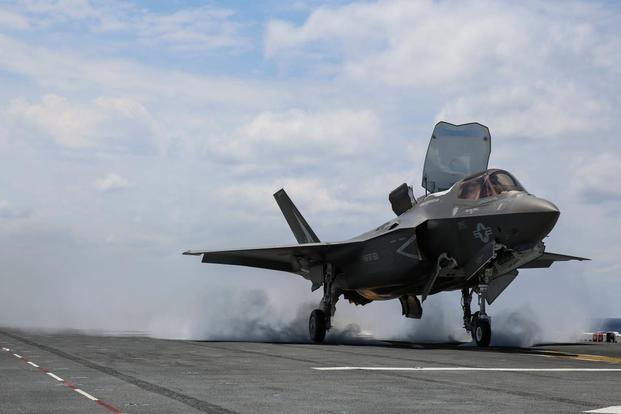After a false start two years ago, the F-35B is finally days away from making its first appearance at the Farnborough International Airshow on July 11, riding a wave of optimism as operational milestones near.
The Marine Corps' F-35B short takeoff and vertical lift variant of the aircraft will be featured at the show, marking the first time the fifth-generation fighter will appear in the U.K. and the first time it is flown overseas by American pilots.
Six F-35s -- three F-35Bs and three of the F-35A variant used by the Air Force -- made the trans-Atlantic flight from the U.S. on June 30 and July 1 ahead of the Royal International Air Tattoo at RAF Fairford in England.
Due to limited hangar space, the F-35A will not appear at Farnborough, returning home after RIAT later this month.
The F-35B was originally supposed to make its first appearance at Farnborough in 2014. Those plans were scrapped when an F-35A fire on the runway at Eglin Air Force Base in Florida caused the Defense Department to ground all F-35s and cancel the aircraft's participation in Farnborough.
It's possible that the cutting-edge aircraft is in a better position now to take advantage of the publicity that Farnborough offers than it would have been in 2014. Despite ongoing concerns about software glitches, an F-35A ejection seat issue that may create risk of neck damage for lighter pilots, and a ballooning lifetime cost to operate the aircraft, the Joint Strike Fighter has achieved key milestones in recent months.
The Marine Corps F-35B achieved initial operational capability on schedule last July and has since activated two squadrons of the aircraft, replacing units of legacy F/A-18 Hornets and AV-8B Harriers. The first deployment of the F-35B to Japan is planned in January.
Reports from RIAT indicate the F-35A is still on track to reach IOC before the end of this year, at which point the service will have between 12 and 14 fully mission-capable aircraft.
During a hearing before a House Armed Services Committee panel on military readiness July 6, Marine Corps Deputy Commandant for Aviation Gen. Jon Davis lavished praise on the fighter.
During a recent Weapons and Tactics Instructor drill in Yuma, Arizona, he said, the aircraft modeled a series of exacting threat scenarios that the Marines' legacy platforms usually take on.
"Generally, about half the airplanes that go into the [range of military operations] for high-end threats ... about half don't make it through," he said. "The F-35s had a 24-0 kill ratio, killed all the targets. It was like Jurassic Park, watching a velociraptor. It kills everything."
One of Davis' sons wants to fly the aircraft for the Marine Corps in the future, the general said, and the other may pursue doing so as well.
Mark Gunzinger, a senior fellow at the Center for Strategic and Budgetary Assessments, told Millitary.com other positive signs for the F-35 program included a decrease in developmental problems, indicating that the platform is maturing, and a decrease in unit cost, as predicted by the Joint Program Office.
Gunzinger said he had spoken with test pilots and trainees who raved about the aircraft after having the chance to familiarize themselves with it.
"It's well known the F-35 really does have a magic cockpit and the ability to take multiple sources of information,: Gunzinger said. "Its situational awareness is unparalleled."
The appearance of the F-35 at Farnborough may also have significance for international customers considering investing in the aircraft. One of the three F-35Bs at Farnborough is intended for England's Royal Air Force.
According to a 2015 strategy document, the U.K. ultimately hopes to buy 138 of the STOVL variant of the aircraft. According to reports, nearly 50 U.K. military personnel are training to fly and maintain the aircraft at Marine Corps Air Station Beaufort, South Carolina, and the U.K. plans to stand up its first operational F-35 unit in 2018.
-- Hope Hodge Seck can be reached at hope.seck@military.com. Follow her on Twitter at@HopeSeck.
Related video:
![]()




























